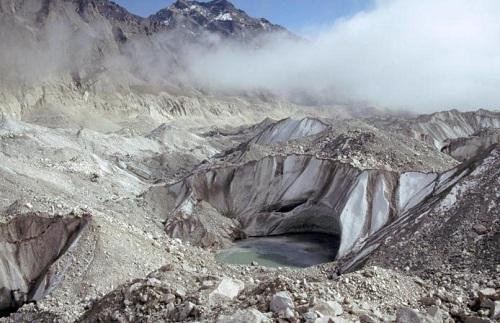Modeling of debris-covered glaciers
Developing modeling systems to determine the melt water production of debris-covered glaciers over a range of spatial and temporal scales

As mountain glaciers recede, they are increasingly becoming covered in rock debris, and in some regions 40 - 70% of the ablation zone of the glacier is covered in rock debris. Understanding the impact of this surface debris on glacier melt is essential if we want to calculate the glacier contribution to regional water resources and global sea level rise.
Conventional wisdom is that debris cover thicker than a few centimeters slows down ice melt, and thus ‘protects’ the ice during periods of glacier recession such as the present. Contradictorily, satellite studies of surface lowering rates of glaciers show that the lowering rate of debris-covered glaciers matches, or even exceeds, that of comparable glaciers with no surface debris.
The premise of this research is that previously unaccounted-for processes associated with the surface properties of the debris-covered area are responsible for the rapid rates of ice loss observed at the glacier scale, and the goal of this research project is to quantify the impact of these processes, and develop numerical models that will allow more accurate prediction of future runoff from debris-covered glaciers.
Project
Project Leader:
Lindsey NICHOLSON
Funding Agencies:
FWF Elise Richter Award (V 309-N26)
Project Duration:
01/09/2013 to 31/08/2017
Publications
2017
Structure and evolution of the drainage system of a Himalayan debris-covered glacier, and its relationship with patterns of mass lossThe Cryosphere11https://www.the-cryosphere.net/11/2247/2017/ Thickness estimation of supraglacial debris above ice cliff exposures using a high-resolution digital surface model derived from terrestrial photographyABSTRACTJournal of Glaciology2441https://www.cambridge.org/core/product/identifier/S0022143017000685/type/journal_article2016
Can a simple Numerical Model Help to Fine-Tune the Analysis of Ground-Penetrating Radar Data? Hochebenkar Rock Glacier as a Case StudyArctic, Antarctic, and Alpine Research48http://www.bioone.org/doi/10.1657/AAAR0014-0812015
Impact of debris cover on glacier ablation and atmosphere–glacier feedbacks in the KarakoramThe Cryosphere9http://www.the-cryosphere.net/9/1617/2015/http://www.the-cryosphere.net/9/1617/2015/tc-9-1617-2015.pdf2014
Representing moisture fluxes and phase changes in glacier debris cover using a reservoir approachThe Cryosphere8http://www.the-cryosphere.net/8/1429/2014/http://www.the-cryosphere.net/8/1429/2014/tc-8-1429-2014.pdfMessner, J. W. ;G. J. MayrA. ZeileisD. S. WilksHeteroscedastic Extended Logistic Regression for Postprocessing of Ensemble GuidanceMonthly Weather Review142http://journals.ametsoc.org/doi/abs/10.1175/MWR-D-13-00271.1, 2014: Extending Extended Logistic Regression: Extended vs. Separate vs. Ordered vs. Censored. Monthly Weather Review, 140515130920004, doi:10.1175/MWR-D-13-00355.1. http://journals.ametsoc.org/doi/abs/10.1175/MWR-D-13-00355.1.
2013
, 2013: Brief communication "Spatial and temporal variation of wind power at hub height over Europe". Nonlinear Processes in Geophysics, 20, 305 - 310, doi:10.5194/npg-20-305-2013. http://www.nonlin-processes-geophys.net/20/305/2013/npg-20-305-2013.pdf.
